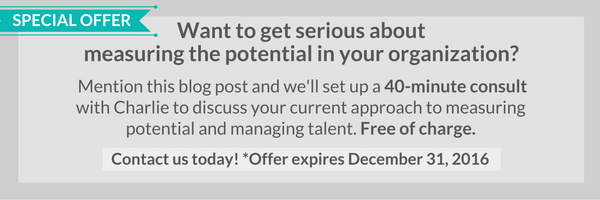If you missed Part 1 of this Q&A, be sure to check that out here before reading Part 2.

Last month, hfi broadcast a live Webcast called Putting the Science of Potential to Work. We addressed potential as the most effective predictor of success at all levels of leadership, from supervisors to CEOs. Potential has a profound effect on how we recruit, select, develop and promote our leaders but many organizations struggle to effectively define and/or measure potential.
hfi CEO Charlie Atkinson talked through defining, quantifying, and measuring potential and how to use these metrics to hire, promote, and develop the right people for your organization. If you missed the live event, you can watch the Webcast OnDemand or download the slides here.
During the live event, participants asked some great, practical questions about how to begin measuring potential in their organizations and how that measurement integrates with their current methods, like 9-Box Grids. Charlie didn’t have a chance to answer them all on-air so we answered them here in a 2-part blog post.
For Questions 1-3 and their answers, see Part 1 of this post.
Question 4: What if Indicators of Potential themselves change over time? – Anand S
hfi: Contextual components of potential certainly do change, like what roles or opportunities are available to a person. But core personality and ability characteristics such as how quickly a person is able to learn new skills or how competitive and driven they are, are very stable in adults. Once you know what you mean by potential you can separate out the contextual elements, such as willingness to relocate, from the innate characteristics of personality and ability. This allows you to really home in on those that have long term potential.
Question 5: Would you recommend embedding psychometrics into the organization as part of your succession planning? – Harriet
hfi: Yes. Planning someone’s future at a company depends completely on their potential, or their capacity for success as they rise through the ranks. Succession planning is a must-do when it comes to managing your talent, but it can seem impossible to see into the future without being able to predict how they will perform. Psychometrics not only show you a person’s potential in their starting role, but they show you if that person is likely to be able to develop into a role several levels above their current one. Organizations that have included psychometrics in their selection and promotion processes have a wealth of information on their people’s capabilities on which to base succession plans.
Question 6: What are your thoughts on how to identify newer in career talent and those who are most likely candidates for future C-suite roles? – Cheryl
 hfi: During the Webcast we introduced hfi’s Onion Model. The onion illustrates which components of a person change over time and which are more stable. Things like cognitive ability and most aspects of personality are very stable in adults. The factors of personality that come out of 16pf, for example, really only change if the person undergoes a serious trauma or major life event. People’s attitudes to work, approach to risk and so forth change as they move through stages of life and gain different experiences. And many management skills, such as planning projects, analyzing data and dealing with conflict can be taught to people as they progress through their careers. So, while some aspects of a new, young hire — the outer layers of the onion — may change as they grow older, there are also plenty of reliable measures of potential that can be measured early on to help identify those who are more likely to progress to senior management roles.
hfi: During the Webcast we introduced hfi’s Onion Model. The onion illustrates which components of a person change over time and which are more stable. Things like cognitive ability and most aspects of personality are very stable in adults. The factors of personality that come out of 16pf, for example, really only change if the person undergoes a serious trauma or major life event. People’s attitudes to work, approach to risk and so forth change as they move through stages of life and gain different experiences. And many management skills, such as planning projects, analyzing data and dealing with conflict can be taught to people as they progress through their careers. So, while some aspects of a new, young hire — the outer layers of the onion — may change as they grow older, there are also plenty of reliable measures of potential that can be measured early on to help identify those who are more likely to progress to senior management roles.
Question 7: What should we do if the results from the psychometric tests contradict what we found from interview? – Chan
hfi: Great question. If the results of the interviews always matched the results of the psychometrics, there would be no value in doing both. However the two compliment each other extremely well. The psychometrics can provide a very effective guide to the questions you need to ask in the interview. It is important to remember that personality and ability questionnaires are measuring innate characteristics and don’t make allowance for the skills and knowledge that a person has built up through experience or training. So when one of our reports highlights a limitation, you will want to explore that in the interview. It is possible that the person has developed very acceptable strategies for overcoming this limitation. For example a senior manager who is inherently disorganized might have learnt to keep effective to-do lists, or they might rely heavily on the support of a good personal assistant. Either technique could be an effective way to mitigate their disorganized personality. The interview is the perfect opportunity to find out if the person is aware of their limitations and has developed coping strategies to manage them. By combining the two techniques you will home in on the important questions very quickly, reducing the number of interviews you need and so also reducing your time to hire, all while greatly increasing the effectiveness of your selection process.
Thanks again to all of you who joined us for the live Webcast, and to those who submitted questions. If you did not have a chance to join the webcast, please check out the OnDemand video here.
If you have more questions about the science of potential, contact us today!



